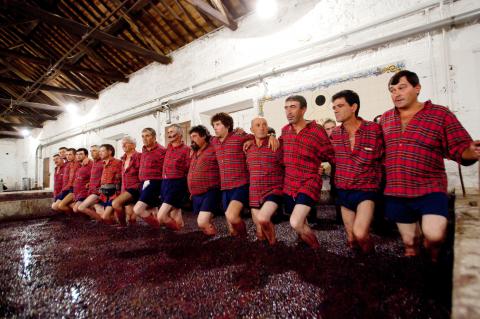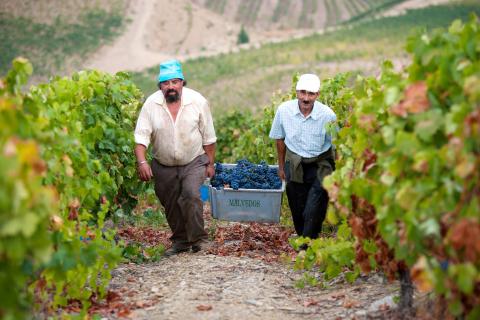Be warned: Stopping for a sandwich in Porto might floor you for the rest of the afternoon, at least if you tuck into the local specialty, a Francesinha — generous amounts of steak and cured ham stuffed between slices of toast, swathed in a mass of melted cheese and then doused with a boozy tomato sauce, with chips and beer optional but recommended. On the bright side for the health conscious, there’s plenty of chance to walk it off in Porto’s vertiginous streets, which rise up from the banks of the Douro river in a jumble of winding paths, broad avenues and shady squares. And multiple opportunities to stop and stare: at the 20,000 blue-and-white tiles (azulejos) depicting scenes from Portuguese history in the Sao Bento railway station; at the iron facades that adorn countless shops and restaurants, and which will, our guide assures us, survive the city’s gradual modernization; at the city’s magnificent Romanesque cathedral; at the famous and wonderfully preserved Lello bookshop, in which a diminutive cart distributes stock on a shopfloor railway. If you get lost, navigate by the tall bell tower of the Clerigos church, visible from virtually everywhere in the city; or by the surviving sections of the 14th-century Fernandine defensive walls, hewn out of the granite on and out of which Porto is built.
Chances are, though, that these and other attractions — the vast glass-and-steel Casa da Musica designed by Rem Koolhaas, the Serralves Museum of Contemporary Art in its beautifully landscaped gardens — are not the first things that spring to mind when you think of Porto. They aren’t for my father — a semi-retired sommelier — or me. Speculating about what to expect, we can muster only one word: port.
It’s a correct but partial view that the city’s tourism officials, hoteliers and restaurateurs are keen to expand by drawing attention to Porto as a breath-of-fresh-air alternative to other European destinations, such as Barcelona, Berlin and Amsterdam. For the first two nights, we stay in the palatial Yeatman hotel, which sits overlooking the Douro from the Vila Nova de Gaia region on the south side of the river. Barely a year old, the hotel is the brainchild and pet project of Adrian Bridge, the managing director of Taylor’s, and although port and wine are central to its aesthetic — from the decanter-shaped swimming pool to the Caudalie Vinotherapie treatments in the vast spa — he is keen to make sure Porto no longer hides its light under a bushel.

Photo: Bloomberg
For the fairly well-heeled traveler, the Yeatman is a luxurious and comfortable base, all hushed corridors you could drive a car down and impeccable service; right next to the byzantine network of narrow roads that connect the city’s long established port-wine cellars and a short hop over one of Porto’s six river bridges to the bustling north side. Those who prefer to stay right in the heart of town might try the Teatro, a more modern (and modestly priced) hotel that takes its design inspiration from the theater that stood on the site in the 19th century. Going upscale again, there’s the five-star, almost implausibly beautiful Infante Sagres, where the likes of Bob Dylan and the Dalai Lama have stayed. We don’t bunk in with them, but the hotel has recently opened a brasserie-style restaurant called Book, and we enjoy a delicious dinner there.
We also visit a couple of posher establishments that seem to fall in with the image of the hip new Porto currently being promoted. They are fine, but it seems to both of us that they offer the kind of food and atmosphere not hard to find in most European capitals; self-consciously refined, artfully presented, comparatively expensive. But the one culinary experience not to miss is eating barbecued sardines in the harbor district of Matosinhos, a short drive from the city center. Follow the smoke and head for the Rua Herois de Franca, where you can take your pick from a lengthy row of plainly decorated restaurants, each with an outsized pavement grill and bursting with people — all piscine life is on the menu, but the sardines, newly caught and whacked on the barbecue with nothing but salt, are sensational (and unfeasibly cheap).
Porto’s enthusiasts are right to point out that there’s far more to the city than its most famous product, but you’d be unwise not to pay it some attention. Sit on the banks of the river and sip it in its white, pink, ruby, tawny and late-bottled vintage incarnations, looking idly at the rabelo boats that are now a tourist attraction but were traditionally used to transport casks of the stuff down river from the Douro Valley. And, if you’re here for more than a couple of days, don’t miss out on the chance to head further inland to the small towns and never-ending vineyards of the Douro itself, less than a couple of hours away by car and also reachable by train to Regua or Pinhao, or by river cruise. We drive and experience proper dropped jaws when we turn off the motorway and arrive at the first viewing point: From high up, all you can see is a vast expanse of broad river and enough grapes, it seems, to keep the world drunk for ever.

Photo: Bloomberg
In 24 hours, we manage to lunch on roast kid at Regua’s splendid Castas e Pratos restaurant, visit the Douro museum, relax in the cool luxury of the Aquapura spa hotel and sample the wares of no fewer than four different quintas (including the Quinta do Seixo, owned by Sandeman, where, somewhat comically, we are shown around by a man in the trademark black hat and cape). At one, the family-owned Quinta da Pacheca, my dad and I sample the delicious wines and port so comprehensively that a cooling swim and a short nap are required before dinner (after which, of course, more port). We’re certainly not up to the grape-treading that you can participate in at some of the smaller quintas — although most grape-crushing is now mechanized, traditional methods are still to be found. Spittoons are not much in evidence and so a word of caution: Unless you are teetotal and have nerves of steel, consider enlisting the services of a driver to take you on quinta visits. When we visit, during the September harvest, the fairly challenging roads are further complicated by the constant traffic of grape trucks.
By the end, I feel I know more about port wine than I had imagined possible: that its grapes grow so well here because of the schist soil that regulates night-time temperatures; that one of its greatest producers was a woman named Dona Antonia Adelaide Ferreira; and that the little chapels that dot the riverside sprang up to bless the rabelo boatmen who might come a cropper in its treacherous shallows. I also realize that I will come back — here and to Porto — time and again, and that its champions are right to think it can give other destinations a run for their money.
Warning: Excessive consumption of alcohol can damage your health

On April 26, The Lancet published a letter from two doctors at Taichung-based China Medical University Hospital (CMUH) warning that “Taiwan’s Health Care System is on the Brink of Collapse.” The authors said that “Years of policy inaction and mismanagement of resources have led to the National Health Insurance system operating under unsustainable conditions.” The pushback was immediate. Errors in the paper were quickly identified and publicized, to discredit the authors (the hospital apologized). CNA reported that CMUH said the letter described Taiwan in 2021 as having 62 nurses per 10,000 people, when the correct number was 78 nurses per 10,000

As we live longer, our risk of cognitive impairment is increasing. How can we delay the onset of symptoms? Do we have to give up every indulgence or can small changes make a difference? We asked neurologists for tips on how to keep our brains healthy for life. TAKE CARE OF YOUR HEALTH “All of the sensible things that apply to bodily health apply to brain health,” says Suzanne O’Sullivan, a consultant in neurology at the National Hospital for Neurology and Neurosurgery in London, and the author of The Age of Diagnosis. “When you’re 20, you can get away with absolute

May 5 to May 11 What started out as friction between Taiwanese students at Taichung First High School and a Japanese head cook escalated dramatically over the first two weeks of May 1927. It began on April 30 when the cook’s wife knew that lotus starch used in that night’s dinner had rat feces in it, but failed to inform staff until the meal was already prepared. The students believed that her silence was intentional, and filed a complaint. The school’s Japanese administrators sided with the cook’s family, dismissing the students as troublemakers and clamping down on their freedoms — with

As Donald Trump’s executive order in March led to the shuttering of Voice of America (VOA) — the global broadcaster whose roots date back to the fight against Nazi propaganda — he quickly attracted support from figures not used to aligning themselves with any US administration. Trump had ordered the US Agency for Global Media, the federal agency that funds VOA and other groups promoting independent journalism overseas, to be “eliminated to the maximum extent consistent with applicable law.” The decision suddenly halted programming in 49 languages to more than 425 million people. In Moscow, Margarita Simonyan, the hardline editor-in-chief of the